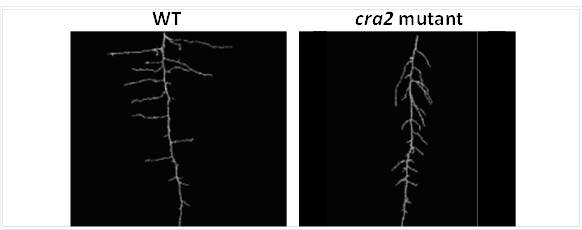Systemic regulation of lateral root angle
Systemic regulation of lateral root angle and root system architecture
The CEP signaling peptide pathway controls from shoots the angle of lateral root formation and thus root system architecture
Lateral root (LR) growth impacts plant resource acquisition and root system architecture
(RSA). The genetic networks that control RSA remain unresolved. In a publication in New Phytologist (Chapman et al., 2020), the teams of Pr. Michael Djordjevic and Pr. Ulrike Mathesius (Canberra University, Australia), in collaboration with Pr. Malcolm Bennett (Nottingham University, UK) and Florian Frugier at IPS2 (Saclay University) revealed using X-ray Computed Tomography and grafting that Arabidopsis and Medicago truncatula CEP (C-TERMINALLY ENCODED PEPTIDE)-CEP RECEPTOR (CEPR) signalling controls RSA. This control was achieved by modulating the LR gravitropic set-point angle(GSA) systemically from shoots.
Mutants of Arabidopsis CEPR1 and M. truncatula CRA2 (Compact Root Architecture 2) orthologousreceptors indeed displayed a narrower RSA, underpinned by steeper LR GSAs. Grafting showed that the loss of CEPreceptor in the shoot lead to this phenotype. Applying the auxin phytohormone to wild-type (WT) shoots induced asteeper GSA that mimickedCEP receptor mutant GSAs. CEPreceptormutantsexhibited increased rootward auxin transport and elevated shoot auxin levels. Concordantly, CEP peptide treatments increased LR GSA and inhibited rootward auxin transport in WT but not in CEP receptormutants. Finally, synthetic auxin transport inhibitors counteracted the steep LR GSA phenotype of CEPreceptor mutants.
Overall, these results demonstrate that CEP peptide - CEP receptor-dependent signalling outputs are shared between Arabidopsis and Medicago plantsto control RSA and LR GSA through the modulation of shoot auxin levels and rootward auxin transport. Modulating CEP signalling strength or manipulating CEP receptor downstream targets appear therefore as a promising strategy to alter RSA.

Figure 1. X-ray Computed Tomography images of Wild-Type (WT) M. truncatula plants (left) and “compact root architecture 2” (cra2) CEP receptor mutants (right), showing respectively a large lateral root gravitropic set-point angle (GSA)/shallow root system architecture (RSA), or in contrast a narrow GSA/steep RSA.
